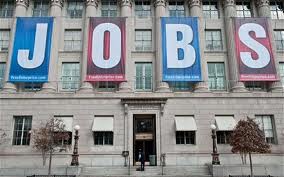Here’s today’s ‘Just A Minute’ bringing you a 60 second summary of what’s happening in the financial markets:
Main Trading Event Of The Day: U.S. Non-Farm Payrolls @ 12.30 GMT
WHAT WE’RE WATCHING TODAY
U.S. Job Growth May Be Slowing But Expected To Remain Solid In July
With NFP data due today, U.S. job growth is likely to have cooled slightly in July but should retain enough momentum to suggest the economy remains solid. Non-farm payrolls are expected to have increased by 233,000, a pull back from June’s 288,000 job gain and the monthly average of 272,000 jobs added in the second quarter. It would still, however, mark the sixth straight month that employment has expanded by more than 200,000 jobs, a stretch not seen since 1997. The unemployment rate likely held at a six year-low of 6.1 percent, but could surprise on the downside after surveys showed Americans becoming more upbeat about jobs. The economy grew at a 4.0 percent annual pace in the second quarter after shrinking at a 2.1 percent rate in the first three months of year. While restocking by businesses lifted the figure, growth is seen remaining sturdy for the rest of 2014. The Labor Department will release its employment report, which is closely watched by financial markets around the globe, at 12:30 GMT today. It is set to muster even more attention in the months ahead, as investors seek to gauge when the Federal Reserve is likely to raise benchmark interest rates from near zero, where they have been since December 2008. Fed officials on Wednesday acknowledged that labour market conditions were improving, but that significant slack remained, signaling patience on the rate front. Most economists look for the first increase in the second quarter of next year.The Labour Department will release its employment report, which is closely watched by financial markets around the globe, at 12:30 GMT today.
Dollar Pauses Near Highs Ahead Of Employment Data
Dollar bulls took a step back today ahead of a closely watched jobs report that has the potential to make or break a rally that saw the dollar post its best monthly performance in over a year. The dollar index was steady at 81.449 .DXY having risen 2.1 percent in July to a 10-1/2 month peak of 81.573. The dollar bought 102.78 yen after peaking at a four-month high of 103.15. The question now is whether this is the beginning of a continuing uptrend, one that has frustrated dollar bulls for much of this year or just another false start. The U.S. jobs report due today could provide a clue. With the Federal Reserve not providing any real hints as to when interest rates will rise, markets are looking more and more to economic data to make their own bets. The euro, meanwhile, traded at $1.3389 EUR steadying near a nine-month trough of $1.3366 plumbed earlier in the week. Working against the common currency was data that showed annual inflation in the euro zone fell in July to its lowest since the height of the financial crisis in 2009. This should keep the risk of deflation on policymakers’ radar, although it is unlikely to spur the European Central Bank into immediate policy action when it meets next week.
Market Volatility? Keep Calm And Carry On…
Equity markets have entered a period of increased volatility amid growing uncertainty over the timing of the Federal Reserve’s first rate hike but the message from analysts to retail investors is to keep calm and carry on. The short-term spikes in volatility we have been experiencing could lead to a couple of down days and although volatility is trending higher, it does not mean the equity market will go down. The CBOE Volatility Index, which shows the market’s expectation of 30-day volatility, spiked 27 percent to 16.95 on Thursday, its highest level since April 11, but below the historical average of 20. The move came as the Dow Jones Industrial Average sank 1.9 percent, erasing its gains for the year, and the S&P 500 dropped 2 percent. The U.S. economy expanded at an impressive 4 percent annual rate in the second quarter as activity picked up broadly after shrinking at a revised 2.1 percent pace in the first three months of the year. Furthermore, there are more signs of an improving labour market. With the economy getting stronger, this has fuelled concerns that the Fed may hike rates sooner rather than later.
That sums up today’s highlights! Keep tuned in for all the latest trading news via our social platform and don’t forget to watch closely for today’s NFP data!
We hope you have a profitable day on the markets.








